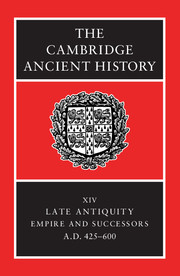Book contents
- Frontmatter
- PART I CHRONOLOGICAL OVERVIEW
- PART II GOVERNMENT AND INSTITUTIONS
- PART III EAST AND WEST: ECONOMY AND SOCIETY
- PART IV THE PROVINCES AND THE NON-ROMAN WORLD
- 18 The north-western provinces
- 19 Italy, A.D. 425–605
- 20 Vandal and Byzantine Africa
- 21a Asia Minor and Cyprus
- 21b Syria, Palestine and Mesopotamia
- 21c Egypt
- 22a The Sasanid monarchy
- 22b Armenia in the fifth and sixth century
- 22c The Arabs
- 23 The Balkans and Greece 420–602
- PART V RELIGION AND CULTURE
- Conclusion
- Chronological Table
- BIBLIOGRAPHY
- Index
- References
23 - The Balkans and Greece 420–602
from PART IV - THE PROVINCES AND THE NON-ROMAN WORLD
Published online by Cambridge University Press: 28 March 2008
- Frontmatter
- PART I CHRONOLOGICAL OVERVIEW
- PART II GOVERNMENT AND INSTITUTIONS
- PART III EAST AND WEST: ECONOMY AND SOCIETY
- PART IV THE PROVINCES AND THE NON-ROMAN WORLD
- 18 The north-western provinces
- 19 Italy, A.D. 425–605
- 20 Vandal and Byzantine Africa
- 21a Asia Minor and Cyprus
- 21b Syria, Palestine and Mesopotamia
- 21c Egypt
- 22a The Sasanid monarchy
- 22b Armenia in the fifth and sixth century
- 22c The Arabs
- 23 The Balkans and Greece 420–602
- PART V RELIGION AND CULTURE
- Conclusion
- Chronological Table
- BIBLIOGRAPHY
- Index
- References
Summary
INTRODUCTION
The 420s mark a turning-point in the history of the Balkan provinces of the Roman empire. Since the 370s the region had been under pressure from various tribes who were themselves being stimulated to challenge the strength of imperial defences by the threat posed to them by the westward movement of the awesome Huns across the south Russian steppe. By 420, but not much before, the Huns had reached the Danube, establishing themselves on the Hungarian plain, asserting their authority over other tribal groups along the Danube, and beginning to challenge Roman imperial authority in both west and east. South of the river, the prosperity of urban and rural life varied. Most cities survived the period of Gothic ravaging and settlement, partly because Goths were not skilled besiegers, but rural hinterlands upon which the vitality of cities depended had been seriously affected. This stimulated a significant change in the pattern of settlement, with the abandonment of isolated rural villages that previously had served as nuclei for exploiting the countryside and a migration of population to the safety of urban defences or upland refuges. Some cities might benefit from an influx of wealthy rural inhabitants who now relocated their grand villas inside the walls, while others in more exposed places received impoverished country people but lost their élites. Walls were strengthened or rebuilt, perhaps to enclose a restricted, more defensible, circuit, though habitation might still extend beyond the central defended area, as at Athens.
- Type
- Chapter
- Information
- The Cambridge Ancient History , pp. 701 - 730Publisher: Cambridge University PressPrint publication year: 2001
References
- 2
- Cited by

